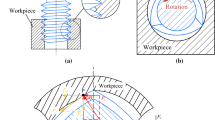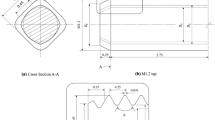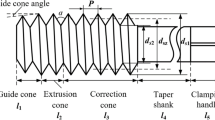Abstract
The tooth height rate of the thread directly determines the connection quality of the thread, and the diameter of the preformed bottom hole of cold extruded thread workpiece determines the size of the tooth height rate. In this paper, according to the theory of equal volume in plastic deformation of metal and combining the crest defects that occur during the extrusion test, a formula for calculating the diameter of the preformed bottom hole of the workpiece in the process of internal thread cold extrusion is deduced. Further, the formula is modified and improved by taking into account the size of the internal thread, the structural parameters of the extrusion tap, and the plastic performance parameters of the workpiece itself. Three metal materials of 40Cr, 45# steel, and Al-6061 aluminum alloy are selected for the workpiece, and the bottom holes of their specimens are preformed according to the formula. And the thread numerical simulation and experimental verification are carried out. It is found that the results of numerical simulation and experimental verification of tooth height rate of the internal thread are almost the same, with the error less than 5%. The tooth height rate of the thread can be guaranteed to be 60 ~ 96% when the thread is extruded within reasonable bottom hole diameter range. It shows that the calculation formula of preformed bottom hole diameter deduced in this paper based on the plastic deformation theory is reliable and can be popularized. It provides a theoretical reference for the determination of the bottom hole diameter in process of internal thread cold extrusion.














Similar content being viewed by others
Data availability
The datasets generated and analyzed during the current study are available from the corresponding author on reasonable request.
Code availability
Not applicable.
References
Kramer P, Groche P (2018) Defect detection in thread rolling processes—experimental study and numericalinvestigation of driving parameters. Int J Mach Tools Manuf 129:27–36
Brando GL, Silva PMC, Freitas SA, Pereira PBD, Lauro CH, Brando LC (2020) State of the art on internal thread manufacturing: a review. Int J Adv Manuf Technol 110(11–12):1–21
Stéphan P, Mathurin F, Guillot J (2011) Analytical study of maximal tapping torque during forming screw process. J Mater Process Technol 211(2):212–221
Zhang SW, Zhang DW, YongFei Wang YF, Zhu Q, Zhao SD, Lu W (2020) The planetary rolling process of forming the internal thread. Int J Adv Manuf Technol 107(5–8):3543–3551
Hou YJ, Zuo DW, Sun YL, Liao ZN (2020) Semi-analytical torque modeling of Ti-6Al-4V-alloy internal trapezoidal thread extrusion forming with an emphasis on low-frequency torsional vibration. J Mater Process Technol 286: 116812
Hou HL, Chen X, Zhao YQ, He YY, Wang CQ (2021) The influence of the bottom hole of cold extruding internal thread on thread quality. Mechanika 27(4):335–341
Wang M (1999) Anti-fatigue manufacturing principle and technology. Jiangsu Science and Technology Press
MAO Su’e, (1984) Cold extrusion of internal threads. Die And Mould Technology 06:32–38
Miao H, MEI Q, Yuan JY, Zheng ZX, Jin YF, Zuo DW, (2016) Low cycle fatigue and strengthening mechanism of cold extruded large diameter internal thread of Q460 steel. Chin J Mech Eng 29(3):556–563
Barooah RK, Paiva JM, Arif AFM, Rawal S, Bose B, Veldhuis SC (2021) Investigation on wear mechanisms of PVD coatings for form taps in threading of Al-Si alloy. Wear 464–465: 203528
Liu M, Ji ZS, Fan R, Wang XG (2020) Finite element analysis of extrusion process for magnesium alloy internal threads with electromagnetic induction-assisted heating and thread performance research. Materials 13(9):2170
Miao H, Zuo DW, Wang HJ, Wang HF (2010) Optimization of tap parameters for internal thread cold extrusion of high strength steel based on genetic algorithm. Key Eng Mater 431–432:434–437
Monka P, Monkova K, Modrak V, Hric S, Pastucha P (2019) Study of a tap failure at the internal threads machining. Eng Fail Anal 100:25–36
Fromentin G, Poulachon G, Moisan A, Julien B, Giessler J (2005) Precision and surface integrity of threads obtained by form tapping. CIRP Ann Manuf Technol 54(1):519–522
Carvalho AOD, Brand OLC, Panzera TH, Lauro CH (2012) Analysis of form threads using fluteless taps in cast magnesium alloy (AM60). J Mater Process Technol 212(8):1753–1760
Mиншaкoв. Уppaпoв. Ceлиeдa (1983) Extrusion tap. National Defense Industry Press
Funding
This research was funded by the Shaanxi Provincial Natural Science Basic Research Project (2019JM-466) and the Shaanxi Provincial Department of Education Special Scientific Research Project (18JK0148).
Author information
Authors and Affiliations
Contributions
Hongling Hou: conceptualization, formal analysis, writing. Guangpeng Zhang: project administration, supervision, reviewing, editing. Chen Xin: Simulation, experiment. Yongqiang Zhao: experiment data analysis.
Corresponding author
Ethics declarations
Ethical approval
The research does not involve human participants or animals, and the authors warrant that the paper fulfills the ethical standards of the journal.
Consent to participate
It is confirmed that all the authors are aware and satisfied of the authorship order and correspondence of the paper.
Consent for publication
All the authors are satisfied that the last revised version of the paper is published without any change.
Conflict of interest
The authors declare no competing interests.
Additional information
Publisher's Note
Springer Nature remains neutral with regard to jurisdictional claims in published maps and institutional affiliations.
Rights and permissions
About this article
Cite this article
Hou, HL., Zhang, GP. & Xin, C. Research on the bottom hole size of internal thread extrusion. Int J Adv Manuf Technol 120, 707–717 (2022). https://doi.org/10.1007/s00170-022-08826-9
Received:
Accepted:
Published:
Issue Date:
DOI: https://doi.org/10.1007/s00170-022-08826-9




